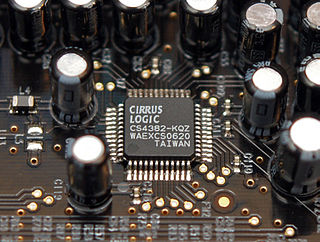Related Research Articles

Analog television is the original television technology that uses analog signals to transmit video and audio. In an analog television broadcast, the brightness, colors and sound are represented by amplitude, phase and frequency of an analog signal.
A codec is a device or computer program that encodes or decodes a data stream or signal. Codec is a portmanteau of coder/decoder.

Digital data, in information theory and information systems, is information represented as a string of discrete symbols, each of which can take on one of only a finite number of values from some alphabet, such as letters or digits. An example is a text document, which consists of a string of alphanumeric characters. The most common form of digital data in modern information systems is binary data, which is represented by a string of binary digits (bits) each of which can have one of two values, either 0 or 1.

Digital video is an electronic representation of moving visual images (video) in the form of encoded digital data. This is in contrast to analog video, which represents moving visual images in the form of analog signals. Digital video comprises a series of digital images displayed in rapid succession, usually at 24 frames per second. Digital video has many advantages such as easy copying, multicasting, sharing and storage.

Video is an electronic medium for the recording, copying, playback, broadcasting, and display of moving visual media. Video was first developed for mechanical television systems, which were quickly replaced by cathode-ray tube (CRT) systems which, in turn, were replaced by flat panel displays of several types.
Data communication or digital communications, including data transmission and data reception, is the transfer and reception of data in the form of a digital bitstream or a digitized analog signal transmitted over a point-to-point or point-to-multipoint communication channel. Examples of such channels are copper wires, optical fibers, wireless communication using radio spectrum, storage media and computer buses. The data are represented as an electromagnetic signal, such as an electrical voltage, radiowave, microwave, or infrared signal.

VHS is a standard for consumer-level analog video recording on tape cassettes invented in 1976 by the Victor Company of Japan and was the competitor to the ill-fated Sony Betamax system.

Digital audio is a representation of sound recorded in, or converted into, digital form. In digital audio, the sound wave of the audio signal is typically encoded as numerical samples in a continuous sequence. For example, in CD audio, samples are taken 44,100 times per second, each with 16-bit sample depth. Digital audio is also the name for the entire technology of sound recording and reproduction using audio signals that have been encoded in digital form. Following significant advances in digital audio technology during the 1970s and 1980s, it gradually replaced analog audio technology in many areas of audio engineering, record production and telecommunications in the 1990s and 2000s.

In electronics, a digital-to-analog converter is a system that converts a digital signal into an analog signal. An analog-to-digital converter (ADC) performs the reverse function.
Sound can be recorded and stored and played using either digital or analog techniques. Both techniques introduce errors and distortions in the sound, and these methods can be systematically compared. Musicians and listeners have argued over the superiority of digital versus analog sound recordings. Arguments for analog systems include the absence of fundamental error mechanisms which are present in digital audio systems, including aliasing and quantization noise. Advocates of digital point to the high levels of performance possible with digital audio, including excellent linearity in the audible band and low levels of noise and distortion.
Loopback is the routing of electronic signals or digital data streams back to their source without intentional processing or modification. It is primarily a means of testing the communications infrastructure.

A camcorder is a self-contained portable electronic device with video and recording as its primary function. It is typically equipped with an articulating screen mounted on the left side, a belt to facilitate holding on the right side, hot-swappable battery facing towards the user, hot-swappable recording media, and an internally contained quiet optical zoom lens.
Professional video over IP systems use some existing standard video codec to reduce the program material to a bitstream, and then to use an Internet Protocol (IP) network to carry that bitstream encapsulated in a stream of IP packets. This is typically accomplished using some variant of the RTP protocol.

Digital artifact in information science, is any undesired or unintended alteration in data introduced in a digital process by an involved technique and/or technology.
Time base correction (TBC) is a technique to reduce or eliminate errors caused by mechanical instability present in analog recordings on mechanical media.
Measurement of wow and flutter is carried out on audio tape machines, cassette recorders and players, and other analog recording and reproduction devices with rotary components This measurement quantifies the amount of 'frequency wobble' present in subjectively valid terms. Turntables tend to suffer mainly slow wow. In digital systems, which are locked to crystal oscillators, variations in clock timing are referred to as wander or jitter, depending on speed.
Packet loss concealment (PLC) is a technique to mask the effects of packet loss in voice over IP (VoIP) communications. When the voice signal is sent as VoIP packets on an IP network, the packets may travel different routes. A packet therefore might arrive very late, might be corrupted, or simply might not arrive at all. One example case of the last situation could be, when a packet is rejected by a server which has a full buffer and cannot accept any more data. Other cases include network congestion resulting in significant delay. In a VoIP connection, error-control techniques such as automatic repeat request (ARQ) are not feasible and the receiver should be able to cope with packet loss. Packet loss concealment is the inclusion in a design of methodologies for accounting for and compensating for the loss of voice packets.
The dbx Model 700 Digital Audio Processor was a professional audio ADC/DAC combination unit, which digitized a stereo analog audio input into a bitstream, which was then encoded and encapsulated in an analog composite video signal, for recording to tape using a VCR as a transport. Unlike other similar pieces of equipment like the Sony PCM-F1, the Model 700 used a technique called Companded Predictive Delta Modulation, rather than the now-common pulse-code modulation. At the time of its introduction in the mid-1980s the device was the first commercial product to use this method, although it had been proposed in the 1960s and prototyped in the late '70s.
Pulse-code modulation (PCM) is a method used to digitally represent sampled analog signals. It is the standard form of digital audio in computers, compact discs, digital telephony and other digital audio applications. In a PCM stream, the amplitude of the analog signal is sampled at uniform intervals, and each sample is quantized to the nearest value within a range of digital steps.
Error concealment is a technique used in signal processing that aims to minimize the deterioration of signals caused by missing data, called packet loss. A signal is a message sent from a transmitter to a receiver in multiple small packets. Packet loss occurs when these packets are misdirected, delayed, resequenced, or corrupted.
References
- ↑ W.K.E. Geddes (14 December 1964). "R&D Report 1964-77: Simple drop-out compensator for video tape recorders" . Retrieved 21 March 2013.